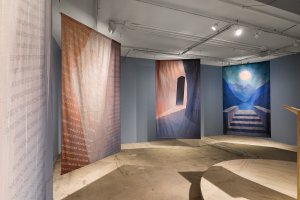K Allado-McDowell: The Known Lost | DAZED
May 09 2025

‘Decenter the human’: How art is shifting the climate conversation
As shows by Björk and K Allado McDowell explore mass species extinction via AI, other artists find different ways to shift our ecological perspectives – here, we speak to some of the key players
The names of approximately 200,000 extinct species are featured in K Allado-McDowell’s new exhibition at Swiss Institute in New York. To the human brain, it’s almost impossible to comprehend such a vast collection of living things, much less their erasure from the Earth and its oceans. “I wanted to just understand what extinction is at a very basic level,” says the artist and writer, who compiled the list alongside their research assistant. Then came the task of condensing all that into something tangible, to create something that humans can wrap their head around.
The result is The Known Lost, a participatory exhibition-slash-opera where visitors can speak or sing the names of lost species, against a visual backdrop that doubles as a prototype for a physical monument, designed to honour all species that have ever lived and died on our home planet. At its heart, says Allado-McDowell: “It’s about making deep time more accessible in the past and in the future, and putting ourselves into a longer continuum.”
By now, it’s no secret that we need to radically rethink our place in nature if we’re to reverse our disastrous impact on Earth’s ecosystems, via anthropogenic global warming, the pollution of rivers and seas, deforestation, fossil fuel extraction, omnipresent microplastics… the list goes on. As Björk and her collaborator Aleph Molinari told Dazed in December last year, human civilisation – particularly in the late-capitalist West – has become dangerously disconnected from these conversations, even as we increasingly feel their effects. “The modern concept of nature itself is problematic,” Molinari says. “Nature came to define what was outside, the savage Other… But nature is everything that we’re part of.”
Like The Known Lost, Björk and Molinari’s Nature Manifesto (2024) honed in on Earth’s extinct species, conjuring their long-lost voices using AI technologies (in collaboration with IRCAM) to fill a mechanical escalator at the Pompidou Centre in Paris. On the surface, it was a poignant reminder of biodiversity loss, but there was a deeper existential thread. Again, the project was about getting us outside our narrow understanding of history, to see ourselves as part of a continuum that goes back millions of years and could stretch millions more years into the future (fingers crossed). In other words, it was about undermining the myth that humans are “at the centre of everything”.
This is not an easy thing to come to terms with. “There’s a trauma involved in decentering the human,” says Allado-McDowell, comparable to the Copernican Revolution (the proof and gradual acceptance of the idea that Earth isn’t specially situated at the centre of the heavens). “But the question is, what comes next? What does it mean to not be the centre?” This, they suggest is where it’s helpful to view things from an ecological perspective, considering the interconnected relationships of organisms and their environment at every scale of life. “It’s helpful to acknowledge that we’re already living in ecological relationships… so it’s not hard to make that leap.”
Counterintuitively, one of the driving factors in our shifting outlook on humanity’s ancient, evolutionary past is a hyper-modern technology: AI. “People see a chatbot, for example, and they say, ‘This thing is using language. It’s reasoning. That’s something that’s supposed to be distinct to humans,’” says Allado-McDowell. This raises a slew of scary questions: “‘Does that mean I’m just the same as a machine? Does the machine have a soul? Is [the machine] alive? Or does that mean I’m just a material process?’” On the other hand, machines that can ‘think’ might prompt us to question what other kinds of intelligence we can see outside our previously-blinkered view, from bee colonies and octopi, to coral reefs and talking trees.
Of course, the use of artificial intelligence in art is itself a complex topic – especially, in this case, when it comes to its environmental impact. Take the comments under Björk’s posts about Nature Manifesto on Instagram, for example. “Please stop using AI”, one reads, and another: “Google ‘AI water usage’.’” Yet another calls artistic AI “a new level of oxymoron”. Allado-McDowell is well aware of the controversy, having “collaborated” with models like GPT-3 on previous projects such as Pharmako-AI. “I’m as much a critic as anybody, because I’m very close to it,” they say, and it’s no exaggeration – they frequently frame the technology as a dangerous toxin. “But I’m also trying to figure out […] what is needed from us to transform that toxin into something that could potentially be healing.”
This nuanced approach echoes Allado-McDowell’s take on mainstream attitudes toward AI at large: “Our kind of flat, binaristic response is insufficient.” Technology, like humans and the rest of the natural world, has to be viewed as part of a bigger, complex ecosystem if we’re to understand the full extent of its pitfalls and potential – how it might change and even help save our rapidly evolving planet. And yes, it’s hard to hold these messy systems, massively distributed across space and time, in our heads, especially when it involves setting our egos aside. But that’s where the imaginative power of art comes in. “I think it’s easy to be pessimistic, especially right now,” says Allado-McDowell. “The way I see it, is that we need freedom to imagine, to imagine new possibilities, [and] to explore the shadow as well. Also, just the psychic freedom to be with what is happening, and to observe it. To the extent that we’re able to maintain that within ourselves, as artists, we will find value in art.”
